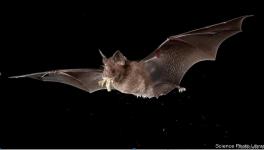Trump Owes Us an Apology, Says Bat Virologist at Wuhan

Image Courtesy: The Print
Shi Zhengli is a scientist at the Wuhan Institute of Virology (WIV) in Wuhan, China, where she has been dedicated to studying bat coronaviruses for more than a decade now. She has published many research papers in acclaimed science journals with her original research findings on bat coronaviruses. Shi’s lab in the WIV has many foreign collaborators and many of them consider her to be an honourable scientist with mastery in the field of virology.
However, since the outbreak of COVID-19 in Wuhan and its spread to other parts of the world, Shi and her lab have been thrust under the spotlight. It was speculated that the novel coronavirus escaped from her lab and spread worldwide, some even said that it was engineered in the lab. US president Donald Trump was at the forefront in declaring that it was Shi’s lab that is to blame for the great humanitarian crisis. More ridiculously, the scientist was even given the name “Bat Woman”.
Although scientific researches now have shown that the virus has a natural origin rather than originating in a lab or being engineered, there still exists speculative perception about the alleged lab origin of the virus.
Now, Shi has come out with a response to the allegations. She said, “U.S. President Trump’s claim that SARS-CoV-2 was leaked from our institute totally contradicts the facts. It jeopardises and affects our academic work and personal life. He owes us an apology.” This came out as an answers to a questionnaire mailed by Science magazine to her.
Shi specially mentioned the decision made by US’s National Institutes of Health (NIH) to stop a grant to the EcoHealth Alliance in New York City which included the researches on bat virus carried out at WIV. “We don’t understand [it] and feel it is absolutely absurd,” she said.
In the last 15 years or so, Shi’s lab has isolated three bat coronaviruses that are related to the SARS outbreak. Here, isolation of virus means a live virus that can grow in cultured cells in a laboratory. Apart from these three bat viruses, her lab has detected 2,000 other bat coronaviruses in fecal, anal and oral swabs from the animal (Bat). But not all of them are isolated, baring those three.
The main point of allegation was the one such previously detected virus that has 96.2% similarity with SARS-CoV-2. The earlier detected controversial bat coronavirus is named as RaTG13.
In 2016, Shi published a paper where a partial genome sequence encoding one of the proteins called RdRp (RNA dependent RNA polymerase) was revealed. At the time the virus was named as 4991. This partial sequence matched 100% with the bat coronavirus RaTG13, which has 96.2% similarity with SARS-CoV-2. This led to the speculation that Shi knew about the novel coronavirus but never revealed.
Also read: ‘Gene Sequence Can Not Lie’: Real Story Behind Emergence of SARS-COV-2
Shi said that 4991 and RaTG13 are exactly the same. Initially, their lab named it 4991 and it was assigned to the bat itself and at that time, only partial sequence of the genome that encodes the RdRp protein was possible. Later on, when the entire genome could be sequenced they switched to the RaTG13 nomenclature. “We changed the name as we wanted it to reflect the time and location for the sample collection. TG stands for Tongguan (the town in Yunnan province where they trapped that bat) and 13 is short for the year, 2013,” she said while revealing the reality behind the nomenclature.
Moreover, Shi’s lab had never isolated that virus, they only detected it in bat fecal samples along with anal and oral swabs samples of the bat. So, the question of growing that virus in the lab does not come into existence.
Interestingly, Shi’s lab received the first batch of the SARS-CoV-2 viral samples on December 30, 2019, as clinical samples of “pneumoniae of unknown etiology.” During that time, it was referred with this name. The clinical samples contained the SARS-CoV-2, which Shi claimed her lab had never came across. Her lab along with other domestic labs in China were quick enough to identify the pathogen and revealed that it is a SARS related coronavirus. They released the genome sequence at an unprecedented speed as early as in January 12.
But with the viral outbreak gaining momentum worldwide, soon rumours and speculations erupted--first on social media and then pronounced by Trump himself--that it had originated in the Wuhan lab. In March, in a Scientific American article that dug into the origin question, it was written, “She frantically went through her own laboratory’s records from the past few years to check for any mishandling of experimental materials, especially during disposal. Shi breathed a sigh of relief when the results came back: none of the sequences matched those of the viruses her team had sampled from bat caves.”
“That really took a load off my mind,” she says. “I had not slept a wink for days.”
When Shi was asked by what message she wants to give to the world, she replied, “With the continuing occurrences of emerging infectious diseases all over the world, scientists are beginning to study the viruses carried by wild animals, which is not only the key to having early warnings of the diseases from those origins, but also an important scientific basis for disease prevention. In this context, I have conducted collaborative research with Dr. Peter Daszak, President and PI of Eco Health Alliance. We have established a good relationship in the fields of virus surveillance and pathogen discovery. Our research team has found a variety of coronaviruses with different sequences in bat populations. Some of them have the potential to spread to humans and animals, such as SARS-related coronavirus, MERS-related coronavirus, SADS-related coronavirus, etc. The findings provide important clues for the prevention and control of infectious diseases.”
She added, “We don’t understand the NIH termination of funding support for our collaborative project and feel it is absolutely absurd. This project should be an international cooperative work aiming to gather scientists from different countries to jointly explore early warnings and predictions of infectious diseases, which will help in vaccine design and drug development to protect us from coronavirus threats. Over the past 20 years, coronaviruses have been disrupting and impacting human lives and economies. Here, I would like to make an appeal to the international community to strengthen international cooperation on research into the origins of emerging viruses. I hope scientists around the world can stand together and work together. The purpose of the search for the origin of a virus is to prevent the recurrence of similar outbreaks which will harm human society, and in this way, we can respond more effectively when an outbreak happens.”
Also read: How the Chinese Authorities and the WHO Handled the Coronavirus
Get the latest reports & analysis with people's perspective on Protests, movements & deep analytical videos, discussions of the current affairs in your Telegram app. Subscribe to NewsClick's Telegram channel & get Real-Time updates on stories, as they get published on our website.















